I’m in Seattle at the annual Professional Association for SQL Server Summit. Today marks the first day of the 3-day summit. Monday was a day of preconference sessions and volunteer sessions capped off with a welcome reception and a Quiz Bowl.
You can refresh this page in your browser whenever you’d like to see my latest notes with timestamps.
Opening Remarks by Wayne Snyder
Wayne Snyder is the current President of the PASS Board of Directors. In January, he’ll be replaced by Rushabh Mehta, the current Executive VP of Finance. Here’s the new PASS Board lineup.
8:00 AM – Wayne’s explaining how things used to be, and how connecting, sharing and learning is different in the age of social networking.
8:01 AM – Summit registrations (not incl. pre/post-conferences) down from 2,445 in 2008 to 2,200 in 2009. PASS’s goal was to be down just 15% from last year’s registrations, but they’re only down 9%. Congratulating Bill Graziano and the PASS marketing team for maintaining momentum.
8:02 – 42% of attendees are first-timers.
8:03 – 98 SQL Server MVPs are here.
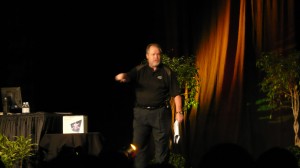
8:04 – Wayne is thanking Jorge Segarra (Blog – @SQLChicken) for his mapping of the user groups.
8:06 – “Our regional events are always without conflict.” Hmm – not sure what that’s supposed to mean. I’m probably reading too much into that. PASS is going to fund and promote as many local and regional events as possible, even when they’re not official PASS events (like SQLSaturday.)
8:07 – 24 Hours of PASS had 50,123 session registrations from 3,524 people from 70+ countries.
8:08 – Relaunching SQLServer Standard as PASS’s flagship publication as a free area of premium content on SQLPASS.org. First article of 2009 posted this week, all back issues will be available online. Encouraging people to submit content and get paid for it. (For the record, I’m nervous about a user group paying people to write content for a free magazine – that doesn’t scale well.)
8:11 – Come meet the board members for an open Q&A on Wednesday in room 6E from 4:30pm to 6:15pm. Will be moderated by Joe Webb.
8:14 – You can get your free copy of SQL Server 2008 Standard Edition at the Product Pavilion. Don’t forget that, really valuable benefit.
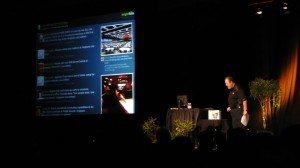
8:18 – Microsoft’s Bob Muglia taking over the stage. He’s telling the story of Microsoft’s original SQL Server announcement back in 1988.
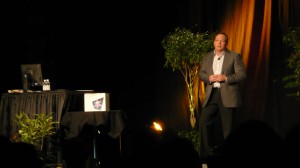
8:21 – Microsoft just handed us a press release. SQL 2008 R2 will have a November CTP, and there’s two new editions coming – Datacenter Edition and Parallel Data Warehouse Edition (formerly Project Madison.) PDWE (as I shall name her) will be available on hardware from Bull, Dell, HP, EMC, and IBM. Not clear who’s providing SAN gear versus hardware – curious to see who’s using which pieces. Datacenter Edition (above Enterprise Edition) supports up to 256 logical processors and unlimited virtualization.
8:25 – Bob’s showing SQL 2008 R2 on IBM x3950 M2’s with 192 CPUs. Custom demo screen lets him spin up more or less CPUs – jumping from 64 to 128 cores. I’ve managed the old x460s that did similar daisy-chaining to get tons of CPU power out of a single box, and while I’m really impressed with the technical achievement, I’m nowhere near as impressed with the cost practicality. I’ll blog more about that later.
8:29 – Announcing that they set a benchmark world record for TPC-E of 2,012 tspE, plus a record data warehouse on Windows TPC-H 3TB 102,778 QphH. He’s emphasizing that SQL Server can handle almost anything.
8:31 – Bob’s saying it’s a transformative time for IT because new workers are used to using Twitter, finding things on the web, and using social computing. We as data professionals need to empower them much more effectively. I think he’s about to announce Microsoft is acquiring Tweet-SQL. (I’m kidding.)
8:34 – If you want more info about the IBM servers that daisy-chain together, here’s an IBM PDF whitepaper on the older version of the servers running SQL Server 2005. It’s got info on the NUMA setup and how to scale SQL Server with it. Keep in mind that these servers were usually deployed with single-core CPUs, so scaling was a little different back then.
8:38 – Edwin Yuen, Senior Product Manager of the MS Virtualization Team is taking the stage to show Live Migration in Windows 2008 R2 Hyper-V.
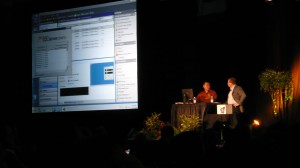
8:41 – Live Migration is pretty unimpressive if you’ve been using VMware ESX for the last few years, but it starts getting more impressive when they throw in phrases like “move to the cloud.” Just dropping hints though.
8:43 – Bob retook the stage, and he’s talking about private clouds. I’m psyched for the long-term impact of this if it adds more than virtualization.
8:46 – They want to provide a coherent programming environment across all platforms – your datacenter, a virtualized datacenter, private cloud, and public cloud. Bob says your SQL skills will continue to pay off.
8:48 – They’re learning things with SQL Azure that will pay off for SQL Server later. For example, the Data-Tier Application (DAC PACK) is focused on the cloud first, and SQL Server second.
8:50 – You need to transform your role into data professionals – helping the business make decisions with data, not just being custodians of it. Get jiggy with your data. (My words, not Bob’s.)
8:51 – Bob’s handing it over to Ted Kummert, the Senior VP for all business platforms (apps plus SQL Server.)
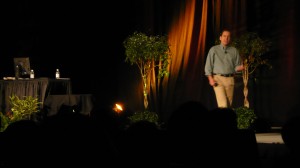
8:54 – Ted’s explaining how all the team’s hard work is coming to fruition in the next 6 months with the release of so many things – Azure, the new Parallel Data Warehouse Edition, R2, etc.
8:56 – Ted’s top 5 reasons of why it’s great to be at #SQLPASS 2009:
- You’re part of the world’s largest gathering of SQL Server professionals.
- You can take your questions to the source – MS employees, product team, SQLCAT team, etc.
- Wayne Snyder and Rushabh Mehta.
- You can work hard and play hard – Microsoft’s GameWorks party should be great.
- You will build skills & knowledge on the #1 database in the world. (Unit leader in database market worldwide, fastest growing RDBMS, leaders wave from Forrester, magic quadrant for Gartner for data warehouse & BI, etc.)
9:02 – Cheerleading over, talking about the next year of releases. Okay, no, wait, more cheerleading – this time about needing less and less fixes in each service pack. They now have standalone service pack uninstall – says that’s the most wanted feature since the release of v6.5. I must be out of touch with what features people want. DBAs, TEST YOUR SERVICE PACKS IN DEV AND QA FIRST. I’m not playing.
9:07 – Bringing on a customer, First American Title, to talk about SQL Server. Now’s my chance to run to the bathroom. Dear God, when will I learn to whiz before the first day’s keynote?
9:12 – I’m back. The IBM demo machines behind the stage must have been left running the demos, because the fans have become deafening. That says a lot in a room this big.
9:18 – Dan Jones is onstage to demo multi-server management.
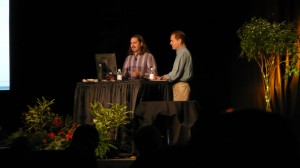
9:22 – They’re demoing the same things I showed in a SQL 2008 R2 video tutorial back in August on SQLServerPedia, except now it’s feature-complete. Looks great, but they’re now talking about shrinking files as “freeing up space for other applications.” Noooo!
9:28 – Demoing Visual Studio’s ability to define rules about where a DAC Pack gets deployed. For example, you could require clustering or x64 servers. The challenge with this for DBAs is that in order to see what’s going on inside the DAC Pack, you’ll need to bust out Visual Studio.
9:31 – Woohoo! The latest build of Visual Studio creates DAC packs that you can apply to existing deployed applications, and upgrade their schema. For example, in Visual Studio you can add a middle name to an existing schema, and generate a new DAC pack. Hand that DAC pack file to a client’s DBA, and it will automagically look at their schema and upgrade it to the new one – no schema comparison required, no guessing on what the schema last looked like. Much easier app upgrades.
9:33 – Bob’s back onstage talking about developer-focused features around the Entity Framework, BI-focused features like consuming data feeds from SharePoint, and platform-focused features like interoperability with other languages.
9:34 – Pablo’s onstage to demo DAC packs and the Entity Data Model in Visual Studio Beta 2 with the .NET Framework 4. I’m not gonna lie to you – it’s flying way over my head. Or around my interests, something like that. Couldn’t care less. I’m not seeing excitement on the Twitter feed either, so I’m guessing I’m not the only one. When Pablo says things like, “You can either build the app or the data model first,” it makes my ears hurt.
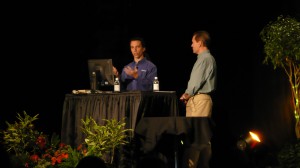
9:42 – I’m still kinda stunned that they’re spending so much time on Visual Studio at the day 1 PASS keynote. If you had any doubt about Microsoft’s focus on developers, you see it now.
9:45 – StreamInsight will release in SQL 2008 R2, and the programming interface will show up in Visual Studio. Talking about how McLaren uses StreamInsight to pull performance data off Formula 1 cars. Now THAT would have made a compelling demo.
9:49 – Ted’s back and talking about pervasive insight – end user access to BI. Touching on Master Data Services in SQL Server 2008 R2.
9:51 – They’re demoing Master Data Services in a web browser.
9:58 – Demoing scale-out loads of a 10 terabyte data warehouse with 60 billion rows. They loaded 60 million additional rows in a matter of seconds, did aggregations of several billion in a matter of seconds, etc. Just looks gorgeous.
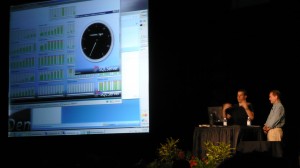
10:00 – Showing visualizations off the massive data warehouse using Report Builder with sparkline graphs and bar graphs. Reports running very quickly off a 20-node, 336-core system.
10:03 – Ted’s talking about Azure. Says it’s not a new platform – it’s a new method of delivery for an existing platform. Azure is feature-complete as of today.
10:08 – Azure demo starting onstage, but everybody in the crowd is leaving. Sessions start at 10:15, and everybody needs seats in the sessions because they’re first-come-first-serve. Even some of the bloggers left.
10:09 – Showing SQL Azure Data Sync – sorta like 2-way replication between your database and the cloud. Uses a background agent to manage change.
10:13 – Demoing connectivity between Visual Studio and Azure, so you can deploy your DAC Packs from within Visual Studio. (Not SQL Server Management Studio – think about that for a second. Deploy databases as a developer without getting DBAs involved.)
10:14 – Ted hints that Parallel Data Warehouse Edition will be delivered later than SQL 2008 R2. Makes sense, because there’s hardware vendors involved. Looks like you have to buy it in a package from the hardware vendor. I’ll ask more about that.
That’s all folks! Off to the SQLServerPedia booth.


5 Comments. Leave new
Good info. Keep updating for us unfortuante people who did not make it to SQLPASS this year.
Hey Brent,
Excellent post for those of us who couldn’t make it this year!
A note about the IBM hardware: IBM does have a more recent “redpaper” on the x3950 and SQL Server 2008 here: Running Microsoft SQL Server 2008 on the IBM System x3950 M2
We’ve got a few of them here, and they’re pretty darn good.